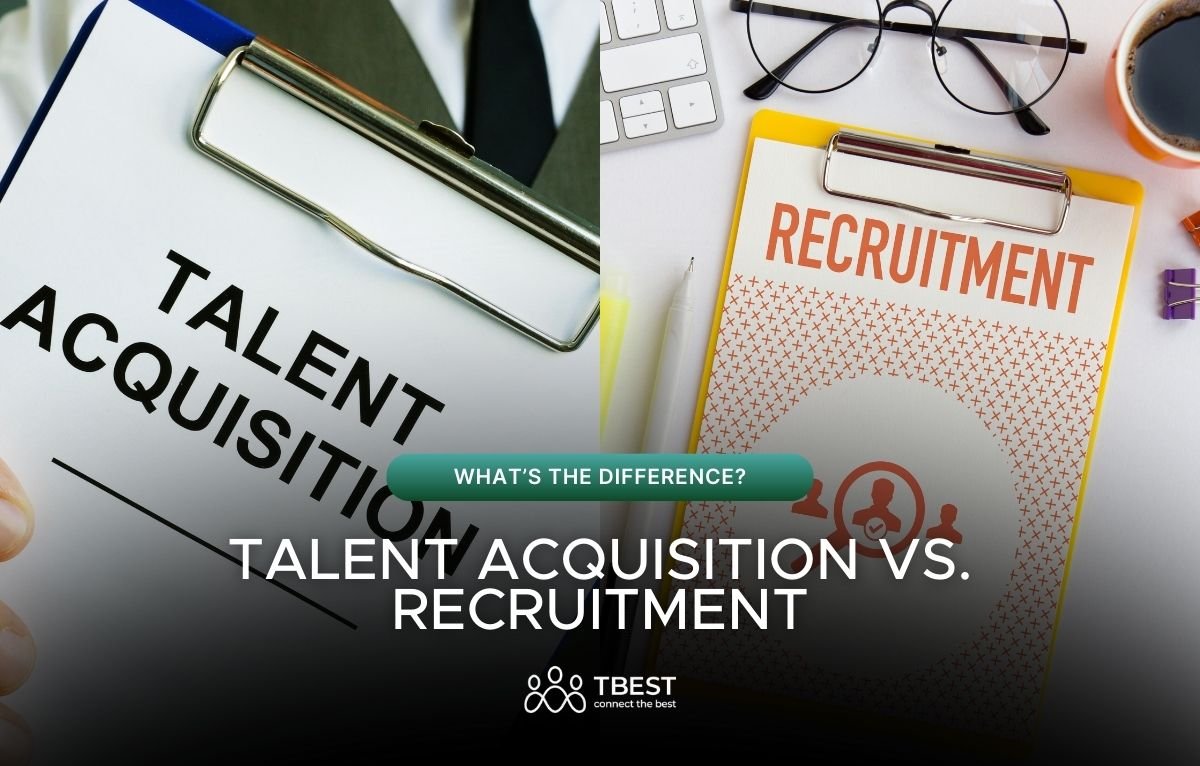
When businesses aim to build strong teams, the terms “talent acquisition vs recruitment” often come into play.
While these concepts are closely related, they aren’t interchangeable.
Learning their differences can help companies create strategies tailored to their goals and long-term success.
Core Difference Between Talent Acquisition and Recruitment
Recruitment focuses on filling immediate job vacancies. It is often a reactive process, initiated when a specific role needs to be filled quickly. For example, if a company loses a team member, recruitment steps in to find someone with the required skills to replace them as soon as possible.
This process typically involves posting job ads, reviewing applications, conducting interviews, and onboarding a new hire. Recruitment is short-term and primarily task-oriented.
Talent acquisition, on the other hand, is a strategic and forward-thinking process. It aims to build a robust pipeline of skilled professionals who align with the company’s culture and future needs.
This approach looks beyond filling vacancies and emphasizes long-term goals, such as succession planning and workforce development.
Talent acquisition is proactive and strategic, ensuring that the right people are ready to step into key roles as the business grows.
When we think about “talent acquisition vs recruitment,” the distinction becomes clear: recruitment solves immediate hiring needs, while talent acquisition builds a sustainable workforce for the future.
Why Businesses Need Both Approaches
While the difference between talent acquisition and recruitment is apparent, businesses benefit from integrating both into their hiring strategies.
Recruitment addresses the urgency of filling gaps in the workforce, ensuring operations continue without disruptions.
For instance, a manufacturing company experiencing a sudden shortage of workers can rely on recruitment to fill those positions quickly.
On the other hand, talent acquisition ensures the company is ready to meet its future goals. It aligns closely with the organization’s overall vision and involves understanding market trends, identifying potential candidates well in advance, and nurturing relationships with top talent.
For example, a tech company planning to expand into AI development might use talent acquisition strategies to connect with professionals who have niche expertise in this area, even if they don’t have current openings for those skills.
The keyword “talent acquisition vs recruitment” highlights the importance of recognizing their complementary roles.
Combining these approaches allows businesses to address immediate needs while building a workforce that can adapt to future challenges.
How Organizational Goals Shape the Choice
A company’s objectives often determine whether it leans more toward recruitment or talent acquisition.
Organizations undergoing rapid expansion may find talent acquisition more beneficial, as it helps establish a steady pipeline of skilled professionals.
In contrast, businesses with fluctuating hiring needs or seasonal demand may focus on recruitment to address short-term gaps.
For example, a retail company ramping up its workforce for the holiday season will rely on recruitment to onboard temporary staff quickly.
On the other hand, a healthcare organization aiming to establish a specialized cardiology unit will benefit more from talent acquisition strategies, ensuring it has access to highly skilled professionals when the unit launches.
When evaluating “talent acquisition vs recruitment,” it’s essential to consider how the company’s goals align with each approach.
This understanding ensures hiring strategies are tailored to meet both present and future workforce demands.
Role of Technology in Talent Acquisition and Recruitment
Technology has significantly influenced both talent acquisition and recruitment processes.
Recruitment platforms streamline tasks such as posting job ads, filtering applications, and scheduling interviews. These tools are particularly valuable in recruitment, where speed is a priority.
Talent acquisition also benefits from technology, but its use extends beyond the immediate hiring process.
Advanced tools, such as AI-powered talent management systems, enable companies to analyze workforce trends, identify potential candidates, and maintain engagement with top talent.
These systems support a proactive approach, ensuring the organization is prepared to meet its future needs.
Even if you’re using recruitment tools for immediate hiring or talent acquisition platforms for long-term planning, technology plays a crucial role in bridging the gap between these two processes.
The keyword “talent acquisition vs recruitment” serves as a reminder of how technology adapts to support both approaches, depending on a company’s priorities.
Why Culture Fit Matters in Both Approaches
Hiring isn’t just about skills; it’s also about finding individuals who align with the company’s culture. Both recruitment and talent acquisition play a role in achieving this goal, though their methods differ.
Recruitment may focus on immediate skills and qualifications, but cultural fit is often considered during interviews to ensure the new hire will integrate well with the team.
Talent acquisition, however, takes this a step further by prioritizing cultural alignment from the start. By building relationships with potential candidates over time, talent acquisition allows organizations to gauge whether these individuals embody the company’s values and vision.
The emphasis on culture underscores the difference between “talent acquisition vs recruitment” and why both approaches are critical.
Recruitment ensures the right skills are brought into the team quickly, while talent acquisition ensures those skills align with the company’s long-term goals and values.
Choosing the Right Partner
When comparing “talent acquisition vs recruitment,” it’s clear that both play essential roles in workforce development.
Recruitment solves immediate hiring challenges, while talent acquisition builds a foundation for sustained growth.
At TBest Services, we help businesses balance these approaches, ensuring they meet their present needs without losing sight of the future. By partnering with us, you’ll gain access to tailored solutions that align with your goals and create a workforce strategy that works for your unique needs. Learn more about how we can help by visiting TBest Services.

